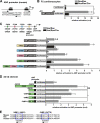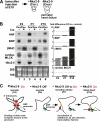Differential role of Nkx2-5 in activation of the atrial natriuretic factor gene in the developing versus failing heart
- PMID: 21930795
- PMCID: PMC3209251
- DOI: 10.1128/MCB.05940-11
Differential role of Nkx2-5 in activation of the atrial natriuretic factor gene in the developing versus failing heart
Abstract
Atrial natriuretic factor (ANF) is abundantly expressed in atrial cardiomyocytes throughout ontogeny and in ventricular cardiomyocytes in the developing heart. However, during cardiac failure and hypertrophy, ANF expression can reappear in adult ventricular cardiomyocytes. The transcription factor Nkx2-5 is one of the major transactivators of the ANF gene in the developing heart. We identified Nkx2-5 binding at three 5' regulatory elements (kb -34, -31, and -21) and at the proximal ANF promoter by ChIP assay using neonatal mouse cardiomyocytes. 3C analysis revealed close proximity between the distal elements and the promoter region. A 5.8-kb fragment consisting of these elements transactivated a reporter gene in vivo recapitulating endogenous ANF expression, which was markedly reduced in tamoxifen-inducible Nkx2-5 gene knockout mice. However, expression of a reporter gene was increased and expanded toward the outer compact layer in the absence of the transcription repressor Hey2, similar to endogenous ANF expression. Functional Nkx2-5 and Hey2 binding sites separated by 59 bp were identified in the -34 kb element in neonatal cardiomyocytes. In adult hearts, this fragment did not respond to pressure overload, and ANF was induced in the absence of Nkx2-5. These results demonstrate that Nkx2-5 and its responsive cis-regulatory DNA elements are essential for ANF expression selectively in the developing heart.
Figures







References
-
- Bar H., Kreuzer J., Cojoc A., Jahn L. 2003. Upregulation of embryonic transcription factors in right ventricular hypertrophy. Basic Res. Cardiol. 98:285–294 - PubMed
-
- Beltrami A. P., et al. 2003. Adult cardiac stem cells are multipotent and support myocardial regeneration. Cell 114:763–776 - PubMed
-
- Bruneau B. G., et al. 2001. A murine model of Holt-Oram syndrome defines roles of the T-box transcription factor Tbx5 in cardiogenesis and disease. Cell 106:709–721 - PubMed
Publication types
MeSH terms
Substances
Grants and funding
LinkOut - more resources
Full Text Sources
Medical
Molecular Biology Databases
